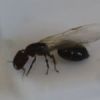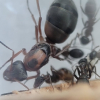Hello everybody!
Having a relatively mature M. barbarus colony (500+) and a young M. capitatus (100) one, I have observed different behaviors of the castes.
It is general belief that major workers act as soldiers, although that is not their main purpose. The main purpose is, of course, cracking and chewing large seeds. This was consistent with my observations when there is a disturbance in the nest (usually by myself at feeding/cleaning time) when a few majors would show up in a "sheriff" fashion, all riled up, checking the situation left and right. However, in my recent experience, their act of "being tough" falls in the water.
I have recently started feeding them live insects, merely to observe their swarming behavior. The majors usually come into contact with the insect in the outworld, realize it is an intruder, and panically run for their lives back into the safety of the nest. Minors and media workers attack as a rule. Especially minors.
I have also detached a part of their habitat for proper cleaning (Messors accumulate a lot of waste, and have interest in street art - in poop ![]() ).
).
I used a paint brush to transfer all ants from the detached habitat module back into the nest. It was easy for the most part; you touch the ant with the brush and they either climb on it in interest, or bite down on it. Majors, on the other hand, panicked all over, proving extremely difficult to transfer.
Thinking about it, it makes sense in the grand scheme of things. The colony has invested more resources into growing a major, so it is more "valuable" to the colony. Plus, it can do a chore no other caste can - crack open large seeds. Minors are "expendable" compared to majors, as they are more numerous and easier to grow from egg.
This kind of goes against the conception of majors doubling as soldiers...
What about other polymorphic species, e.g. Camponotus? I have a C. barbaricus colony (100), but majors mostly stay inside the dirt. I cannot think of a specialized role for the majors other that being soldiers, as Camponotus don't chew seed. Maybe being used as "fridges" in a honeypot ant fashion, only less pronounced?
What are your thoughts/experiences?





















